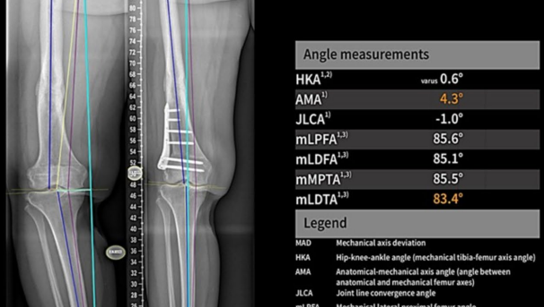
In an Austrian study by Mitterer et al, ImageBiopsy Lab’s AI tool LAMA was used to analyze 110 postoperative knee radiographs from 102 knee osteotomy patients. The study compared the AI's knee alignment assessments with those conducted manually by three readers, demonstrating strong correlation between the AI's assessments and manual measurements (ICC: 0.81–0.99). LAMA accurately analyzed 95.4% of images, with the majority of failures attributed to incorrect tibial joint line detection in images with proximal plates.
Read full study.
Abstract
Introduction
The assessment of the knee alignment on long leg radiographs (LLR) postoperative to corrective knee osteotomies (CKOs) is highly dependent on the reader’s expertise. Artificial Intelligence (AI) algorithms may help automate and standardise this process. The study aimed to analyse the reliability of an AI-algorithm for the evaluation of LLRs following CKOs.
Materials and methods
In this study, we analysed a validation cohort of 110 postoperative LLRs from 102 patients. All patients underwent CKO, including distal femoral (DFO), high tibial (HTO) and bilevel osteotomies. The agreement between manual measurements and the AI-algorithm was assessed for the mechanical axis deviation (MAD), hip knee ankle angle (HKA), anatomical-mechanical-axis-angle (AMA), joint line convergence angle (JLCA), mechanical lateral proximal femur angle (mLPFA), mechanical lateral distal femoral angle (mLDFA), mechanical medial proximal tibia angle (mMPTA) and mechanical lateral distal tibia angle (mLDTA), using the intra-class-correlation (ICC) coefficient between the readers, each reader and the AI and the mean of the manual reads and the AI-algorithm and Bland–Altman Plots between the manual reads and the AI software for the MAD, HKA, mLDFA and mMPTA.
Results
In the validation cohort, the AI software showed excellent agreement with the manual reads (ICC: 0.81–0.99). The agreement between the readers (Inter-rater) showed excellent correlations (ICC: 0.95–0. The mean difference in the DFO group for the MAD, HKA, mLDFA and mMPTA were 0.50 mm, − 0.12°, 0.55° and 0.15°. In the HTO group the mean difference for the MAD, HKA, mLDFA and mMPTA were 0.36 mm, − 0.17°, 0.57° and 0.08°, respectively. Reliable outputs were generated in 95.4% of the validation cohort.
Conclusion
The application of AI-algorithms for the assessment of lower limb alignment on LLRs following CKOs shows reliable and accurate results.
